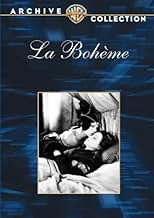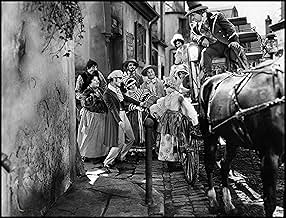CALIFICACIÓN DE IMDb
7.2/10
1.7 k
TU CALIFICACIÓN
Agrega una trama en tu idiomaA group of starving artists try to survive in 1830s Paris, including a seamstress and the would-be playwright she loves.A group of starving artists try to survive in 1830s Paris, including a seamstress and the would-be playwright she loves.A group of starving artists try to survive in 1830s Paris, including a seamstress and the would-be playwright she loves.
- Dirección
- Guionistas
- Elenco
- Premios
- 2 premios ganados en total
Mathilde Comont
- Madame Benoit
- (as Matilde Comont)
Eugene Pouyet
- Bernard
- (as Gene Pouyet)
Agostino Borgato
- Editor
- (sin créditos)
Harry Crocker
- Bit Part
- (sin créditos)
Blanche Payson
- Factory Supervisor
- (sin créditos)
Opiniones destacadas
La Boheme is a notoriously unreleased film that sometimes broadcasts on TCM. Thanks to a great cast featuring Lillian Gish, John Gilbert, and Renee Adoree, it is no wonder why fans clamor to see it. The star power indeed makes the film a good one. The story is one of sadness and heartbreak; two people live struggling to make ends meet in a shabby town in France. He is working as a writer, succumbing to pieces for the newspaper for money while he can flesh out his play. She is a seamstress whose love for him leads her to working herself to death. The love story is tragic and beautiful.
I have never understood the appeal of Gilbert, so I was not as interested in his character or, in consequence, the romantic relationship between he and Gish than I could have been. He is not a bad actor; I simply do not gravitate to his type. Gish is wonderful, however, as a pathetic but beautiful woman. One bright spot of this film was the couple's scenes on a picnic running through the wilderness in the sunlight.
I have never understood the appeal of Gilbert, so I was not as interested in his character or, in consequence, the romantic relationship between he and Gish than I could have been. He is not a bad actor; I simply do not gravitate to his type. Gish is wonderful, however, as a pathetic but beautiful woman. One bright spot of this film was the couple's scenes on a picnic running through the wilderness in the sunlight.
No one else but Lillian Gish would have starved herself for three days to make the final scene, and no one else would have done it so effectively. Would a modern actress have allowed herself to be dragged physically across the cobblestone streets?
Rodolphe (John Gilbert) is a wouldbe playwright struggling for that final bit of inspiration that will lead him to greatness. Mimi (Lillian Gish) is his upstairs neighbor, a seamstress and embroidery expert who works herself to the breaking point. Along with various painters, musicians and other poets, they all struggle to make ends meet until they finally have the success they all crave
The most famous bit of this one is the very ending, but I won't risk spoiling things, only to say that it's milked for all that it's worth. Gilbert looks even more like John Barrymore here, with his tousled hair and piercing eyes. Gish is her usual waifish, saintly self, although she was reportedly anything but offscreen during the making of this, her personal "love letter" to her European fans. I thought the film to be merely decent, with nothing beyond the ending to really recommend it.
The most famous bit of this one is the very ending, but I won't risk spoiling things, only to say that it's milked for all that it's worth. Gilbert looks even more like John Barrymore here, with his tousled hair and piercing eyes. Gish is her usual waifish, saintly self, although she was reportedly anything but offscreen during the making of this, her personal "love letter" to her European fans. I thought the film to be merely decent, with nothing beyond the ending to really recommend it.
It's difficult to imagine what going to the movies was like during the Silent Era. With no soundtracks, and a person in the theater simply accompanying the on-screen action on piano, dramas of the day must have suffered somewhat. But not 'La Boheme'.
As this wonderfully engaging tale of struggling actors and writers in France unfolds, it has a quality to its story telling that would have diminished had it been a talkie. Once you see the frail and beautiful (and quite haunting) Lillian Gish in her key scenes, you will never forget her.
Grab a few hankies and enjoy this singular silent screen treat!
As this wonderfully engaging tale of struggling actors and writers in France unfolds, it has a quality to its story telling that would have diminished had it been a talkie. Once you see the frail and beautiful (and quite haunting) Lillian Gish in her key scenes, you will never forget her.
Grab a few hankies and enjoy this singular silent screen treat!
Lillian Gish is the main reason to watch this film, as the subtlety and range of her expressiveness is on full display here. She is simply magnificent. The film shows signs of creakiness and yet still carries an emotional impact, though I have to say, director King Vidor elongates things as he tries to wring every last ounce of pathos out of it. The film is also hampered by being silent, when you consider how powerful the music from Puccini's opera is.
Gish and John Gilbert were huge stars when this film was made, Gish especially, and there are moments when they light up the screen. My favorite is when they're out on a picnic and she dances about while he chases her. Look for the moment when he catches her, then holds her hands from behind and whispers something in her ear; her look of surprise changing to a backward glance as her body sways forward is wonderful. It's in these types of scenes and when the Vidor puts Gish's face in a tight shot that the film is at its best, and for them, it's worth watching.
Gish and John Gilbert were huge stars when this film was made, Gish especially, and there are moments when they light up the screen. My favorite is when they're out on a picnic and she dances about while he chases her. Look for the moment when he catches her, then holds her hands from behind and whispers something in her ear; her look of surprise changing to a backward glance as her body sways forward is wonderful. It's in these types of scenes and when the Vidor puts Gish's face in a tight shot that the film is at its best, and for them, it's worth watching.
¿Sabías que…?
- TriviaJohn Gilbert was infatuated with Lillian Gish and would mess up his "love scenes" with her on purpose, so he could keep kissing her.
- ErroresThe opening shot of Paris shows Notre Dame Cathedral with its famous spire. At the time the film is set, the 1830s, the spire did not exist. The original was demolished in the early 1790s and not rebuilt until 1860.
- Citas
Title Card: Paris - Mother of the Arts...
- ConexionesFeatured in American Masters: Lillian Gish: The Actor's Life for Me (1988)
Selecciones populares
Inicia sesión para calificar y agrega a la lista de videos para obtener recomendaciones personalizadas
Detalles
- Fecha de lanzamiento
- País de origen
- Idioma
- También se conoce como
- La Boheme
- Locaciones de filmación
- Arcadia, California, Estados Unidos(elaborate picnic in the woods of Ville-d'Avray)
- Productora
- Ver más créditos de la compañía en IMDbPro
Taquilla
- Presupuesto
- USD 693,000 (estimado)
- Tiempo de ejecución1 hora 35 minutos
- Mezcla de sonido
- Relación de aspecto
- 1.33 : 1
Contribuir a esta página
Sugiere una edición o agrega el contenido que falta

Principales brechas de datos
By what name was La Bohème (1926) officially released in India in English?
Responda
































